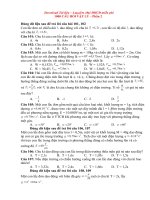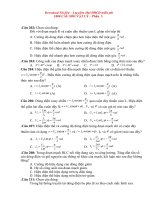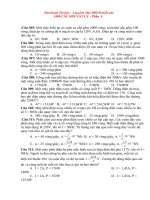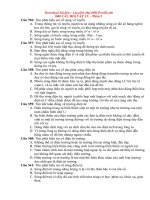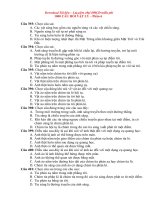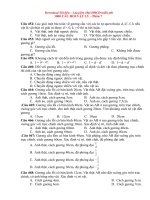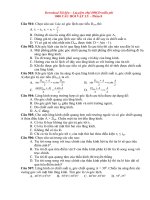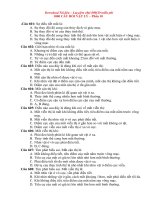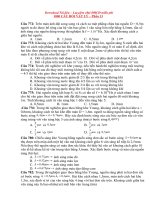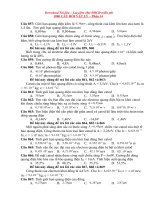Câu hỏi trắc nghiệm về công nghệ thông tin - phần 2 doc
Bạn đang xem bản rút gọn của tài liệu. Xem và tải ngay bản đầy đủ của tài liệu tại đây (205.36 KB, 7 trang )
CCNA 1 V4.0 – Test module – Chapter 2
(Copyright MẠNH HẠO NHIÊN)
(Màu đỏ là đáp án đúng)
1. Which statements correctly identify the role of intermediary devices in the
network? (Choose three.)
1. determine pathways for data
2. initiate data communications
3. retime and retransmit data signals
4. originate the flow of data
5. manage data flows
6. final termination point for data flow
2. Select the statements that are correct concerning network protocols. (Choose
three.)
1. define the structure of layer specific PDU’s
2. dictate how to accomplish layer functions
3. outline the functions necessary for communications between layers
4. limit the need for hardware compatibility
5. require layer dependent encapsulations
6. eliminate standardization among vendors
3. What are two functions of encapsulation? (Choose two.)
1. tracks delay between end devices
2. enables consistent network paths for communication
3. allows modification of the original data before transmission
4. identifies pieces of data as part of the same communication
5. ensures that data pieces can be directed to the correct receiving end
device
4. What is a primary function of the trailer information added by the data link
layer encapsulation?
1. supports error detection
2. ensures ordered arrival of data
3. provides delivery to correct destination
4. identifies the devices on the local network
5. assists intermediary devices with processing and path selection
5. Which two layers of the OSI model have the same functions as the TCP/IP
model Network Access Layer? (Choose two.)
1. Network
2. Transport
3. Physical
4. Data Link
5. Session
6. What is a PDU?
1. corruption of a frame during transmission
2. data reassembled at the destination
3. retransmitted packets due to lost communication
4. a layer specific encapsulation
7. Which characteristic correctly refers to end devices in a network?
1. manage data flows
2. originate data flow
3. retime and retransmit data signals
4. determine pathways for data
8.
Refer to the exhibit. “Cell A” at IP address 10.0.0.34 has established an IP
session with “IP Phone 1″ at IP address 172.16.1.103. Based upon the
graphic, which device type best describes the function of wireless device “Cell
A?”
1. the destination device
2. an end device
3. an intermediate device
4. a media device
9.
Refer to the exhibit. Which three labels correctly identify the network types for
the network segments that are shown? (Choose three.)
1. Network A – WAN
2. Network B – WAN
3. Network C – LAN
4. Network B – MAN
5. Network C – WAN
6. Network A – LAN
10. Which three statements best describe a Local Area Network (LAN)? (Choose
three.)
1. A LAN is usually in a single geographical area.
2. The network is administered by a single organization.
3. The connection between segments in the LAN is usually through a
leased connection.
4. The security and access control of the network are controlled by a
service provider.
5. A LAN provides network services and access to applications for users
within a common organization.
6. Each end of the network is generally connected to a
Telecommunication Service Provider (TSP).
11.
Refer to the exhibit. Which networking term describes the data interleaving
process represented in the graphic?
1. Piping
2. PDU
3. Streaming
4. Multiplexing
5. Encapsulation
12. What is the primary purpose of Layer 4 port assignment?
1. To identify devices on the local media
2. To identify the hops between source and destination
3. To identify to the intermediary devices the best path through the
network
4. To identify the source and destination end devices that are
communications
5. To identify the processes or services that are communicating within the
end devices
13. What device is considered an intermediary device?
1. File server
2. IP phone
3. Laptop
4. Printer
5. Switch
14.
Refer to the exhibit. Which term correctly identifies the device type that is
included in the area B?
1. Source
2. End
3. Transfer
4. Intermediary
15.
Refer to the exhibit. What type of network is shown?
1. WAN
2. MAN
3. LAN
4. WLAN
16. Which layer encapsulates the segment into packets?
1. Physical
2. Data link
3. Network
4. Transport
17. What can be identified by examining the network layer header?
1. the destination device on the local media
2. the destination host address
3. the bits that will be transferred over the media
4. the source application or process creating the data
18.
Refer to the exhibit. Which set of devices contains only end devices?
1. A, C, D
2. B, E, G, H
3. C, D, G, H, I, J
4. D, E, F, H, I, J
5. E, F, H, I, J
19. During the encapsulation process, what occurs at the data link layer?
1. No address is added.
2. The logical address is added.
3. The physical address is added.
4. The process port number is added.
20. What is the purpose of the TCP/IP Network Access layer?
1. path determination and packet switching
2. data presentation
3. reliability, flow control, and error detection
4. network media control
5. the division of segments into packets
21. What is the proper order of the layers of the OSI model from the highest layer
to the lowest layer?
1. physical, network, application, data link, presentation, session,
transport
2. application, physical, session, transport, network, data link,
presentation
3. application, presentation, physical, session, data link, transport,
network
4. application, presentation, session, transport, network, data link,
physical
5. presentation, data link, session, transport, network, physical,
application
(MẠNH HAO5 NHIÊN C10CT9)
×
